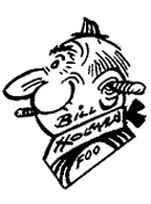This article needs additional citations for verification. (October 2013) |
| Bill Holman | |
|---|---|
 | |
| Born | March 22, 1903 Crawfordsville, Indiana |
| Died | February 27, 1987 (aged 83) New York City, New York |
| Nationality | American |
| Area(s) | Cartoonist |
Notable works | Smokey Stover |
| Spouse(s) | Dolores |
| http://www.smokey-stover.com/ | |

Bill Holman (March 22, 1903 – February 27, 1987)[1] was an American cartoonist who drew the classic comic strip Smokey Stover from 1935 until he retired in 1973. Distributed through the Chicago Tribune syndicate, it had the longest run of any strip in the screwball genre. Holman signed some strips with the pseudonym Scat H. He once described himself as "always inclined to humor and acting silly."[2]
Born in Crawfordsville, Indiana, Holman lived as a child in Nappanee, Indiana, a town where six successful cartoonists lived when they were children. Holman's father died when he was young. He began drawing when he was 12 years old.
While working part-time at Nappanee's local five and dime store, he developed an interest in art as a career and sent away for the Landon School of Illustration and Cartooning correspondence course.[3] Dropping out of high school, he was 15 when he moved with his mother to Chicago. There he took night courses at the Academy of Fine Arts and learned more about cartooning from Carl Ed.
In 1920, he held a job as a copy boy at the Chicago Tribune for six dollars a week. The position gave him the opportunity to hang out with the top Tribune cartoonists, including Sidney Smith, Harold Gray and E. C. Segar.
In Cleveland, he began working for the Newspaper Enterprise Association, which syndicated his short-lived animal strip, Billville Birds (1922). After three years with NEA and Scripps-Howard, he headed for New York, where he was a Herald Tribune staff artist and drew the child strip Junior aka G. Whiz Junior (1923–1931) for the New York Herald Tribune Syndicate. He scored a success when he headed in a new direction, submitting his cartoons to a variety of different magazines, including Liberty, Redbook, Collier's and Life.[4][5]
- ^ "BILL HOLMAN," New York Times (March 21, 1987).
- ^ Goulart, Ron, editor. The Encyclopedia of American Comics, Facts on File, 1990.
- ^ Trickey, Erick. "Quick Draw," Cleveland Magazine, February 2009.
- ^ Bill Holman
- ^ Lambiek